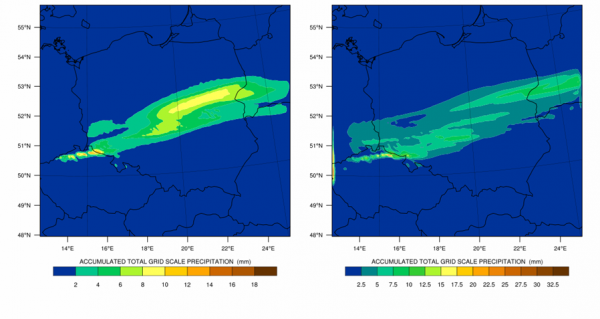Meteorology
Meteorology, from our research perspective, is mainly linked with: 1) innovative applications of GNSS observations in Numerical Weather Prediction models, 2) developing, validating and promoting use of new GNSS observation types in nowcasting.
The Numerical Weather Predictions models are advanced processing packages (Sun et al., 2014) that consist of two interdependent packages: first one that optimally estimate the state of the troposphere based on limited number of heterogeneous observations which is usually called Data Assimilation system. The second one is a set of primitive equations executed on a fine scale grid (Holton and Hakim, 2014), solution to this set of equations in space and time is weather forecast. Together with our strategic partner University of Wroclaw we focus on the GNSS data assimilation: Precipitable Water, Zenith Troposphere Delay, Slant Troposphere Delay, Tomography Wet Refractivity. The GNSS data assimilation research is supported with a NCN project: “GNSS observations as a numerical weather prediction data source, a way forward to enhanced forecast quality” UMO-2013/11/D/ST10/03473.

Another approach, more direct, is the use of GNSS ground-based observations in nowcasting and weather analysis (i.e. www.nwcsaf.org), it is hypothesise that the high-resolution information about the Precipitable Water is necessary to describe thoroughly the state of the atmosphere during severe weather events (widespread rain, convection-originated rainfall), which will enable us to clarify formation mechanism of such events and to explain with high accuracy their spatial distribution. Initial studies by Manning et al., (2012) and Hordyniec et al., (2014) shows that the GNSS could provide Precipitable Water both integrated over the whole atmosphere profile and divided into number of layers applying tomography principle. Currently we are investigating these interesting applications of GNSS in the frame of NCN project: “Precipitable water content (PWAT) as an predictor of extremal weather events in Poland in the light of multi-sources and high resolution measurements”, UMO-2015/17/B/ST10/0382. The leader in this project is University of Wroclaw

We believe that higher intake of GNSS observations in meteorology will aid in understanding severe weather and improve general public safety. The direct access to our data is available through the website http://geo2.igig.up.wroc.pl/ and https://ligig.e-science.pl/
References:
Sun, J., Xue, M., Wilson, J. W., Zawadzki, I., Ballard, S. P., Onvlee-Hooimeyer, J., … & Xu, M. (2014). Use of NWP for nowcasting convective precipitation: Recent progress and challenges. Bulletin of the American Meteorological Society, 95(3), 409-426.
Bennitt, G. V., & Jupp, A. (2012). Operational assimilation of GPS Zenith Total Delay observations into the Met Office numerical weather prediction models. Monthly Weather Review, 140(8), 2706-2719.
Holton, J. R., & Hakim, G. J. (2012). An introduction to dynamic meteorology (Vol. 88). Academic press.
Hordyniec, P., Bosy, J., & Rohm, W. (2015). Assessment of errors in Precipitable Water data derived from Global Navigation Satellite System observations. Journal of Atmospheric and Solar-Terrestrial Physics, 129, 69-77.
